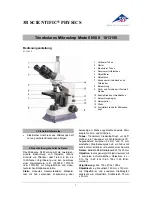
5 OPERATION
5-22
EM210F-1
5.2.8 Film
Processing
1.
Unload the receiving magazine from the camera chamber (
F
Sect. 5.2.3).
2.
Adjourn to a darkroom and remove the lid from the receiving magazine and
the cassettes from the magazine under a safelight (red lamp).
3.
Carefully remove the film from the cassette.
Cassette
Film
Fig. 5.23 Removing the film from the cassette
4.
Immerse the film in a developer (20
±
0.5
℃
); and leave it in until the exposed
latent image becomes sufficiently visible (
F
usually three or four minutes;
Fig. 5.22).
During the developing process, agitate the developer or move the film in
order to avoid developing marks.
?
If only a few films are to be processed, developing trays may be used. However,
if many films are to be processed at one time, it is recommended to use suitable
tanks and hangers (stainless steel tanks, polyvinyl chloride tanks, etc. are the
best).
5.
Immerse the film in a stop bath (2 to 3% glacial acetic acid solution, 18 to
21
℃
) and leave it in for approx. 30 seconds.
This is to suspend development so as to prevent the film from becoming blotchy
and to prolong the effectiveness of the fixer.
6.
Immerse the film in a rapid acid hardening fixer (18 to 21
℃
) and leave it in for
approximately ten minutes (the fixing time should be at least two or three
times the time it takes for the negative to clear).
This is to dissolve the photosensitive silver halide (white part of the film) and
thereby make the unexposed part of the film transparent. Thereafter, processing can
be carried out under an ordinary light.
7.
Wash the film in running water (15 to 20
℃
) for 30 to 60 minutes.
This removes the complex salt and fixing solution. The washing time can be
considerably reduced by immersing the film in a rinse accelerator prior to washing
it in running water.
8.
Immerse the film in a final rinse bath (weak solution of anionic surfactant, 18
to 21
℃
) and leave it in for approx. 30 seconds (or wipe both surfaces of the
film carefully with a soft sponge).
By so doing, film drying time is reduced and film blisters are prevented.
9.
Dry the film in a drying cabinet (the cabinet need not be large); or dry it
naturally by hanging it in a well-ventilated, dust-free place away from direct
sunlight.







































